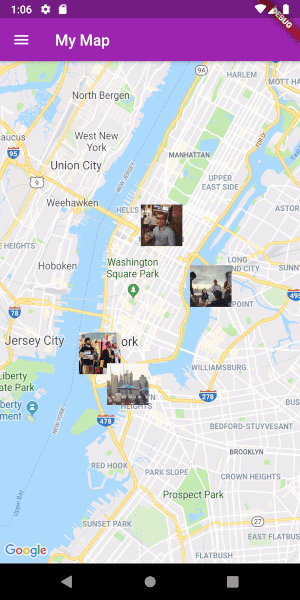Fluster = Flutter + Cluster
A geospatial point clustering library for Dart (Flutter not actually required). The algorithm is a Dart port of supercluster.
Usage
Implement Clusterable
Fluster will cluster a List of objects that conform to the Clusterable abstract class, which includes necessary information such as latitude and longitude:
class MapMarker extends Clusterable {
String locationName;
String thumbnailSrc;
MapMarker(
{this.locationName,
latitude,
longitude,
this.thumbnailSrc,
isCluster = false,
clusterId,
pointsSize,
markerId,
childMarkerId})
: super(
latitude: latitude,
longitude: longitude,
isCluster: isCluster,
clusterId: clusterId,
pointsSize: pointsSize,
markerId: markerId,
childMarkerId: childMarkerId);
}Set up Fluster
Create a Fluster instance once you have a set of points you'd like to cluster:
List<MapMarker> markers = getMarkers();
Fluster<MapMarker> fluster = Fluster<MapMarker>(
minZoom: 0,
maxZoom: 20,
radius: 150,
extent: 2048,
nodeSize: 64,
points: markers,
createCluster: (BaseCluster cluster, double longitude, double latitude) {
return MapMarker(
markerId: cluster.id.toString(),
latitude: latitude,
longitude: longitude);
});Parameters:
/// Any zoom value below minZoom will not generate clusters.
int minZoom;
/// Any zoom value above maxZoom will not generate clusters.
int maxZoom;
/// Cluster radius in pixels.
int radius;
/// Adjust the extent by powers of 2 (e.g. 512. 1024, ... max 8192) to get the
/// desired distance between markers where they start to cluster.
int extent;
/// The size of the KD-tree leaf node, which affects performance.
int nodeSize;
/// The List to be clustered.
List<T> points;
/// A callback to generate clusters of the given input type.
T Function(BaseCluster, double, double) createCluster;Get the clusters
You can then get the clusters for a given bounding box and zoom value, where the bounding box = [southwestLng, southwestLat, northeastLng, northeastLat]:
List<MapMarker> clusters = fluster.clusters([-180, -85, 180, 85], _currentZoom);Get the cluster children
You can also get the children (points and sub-clusters inside a cluster at the next zoom level, given the cluster id:
List<MapMarker> chilren = fluster.children(int clusterId);Get the cluster points
Get only the child points (not sub-clusters) of a cluster in all the remaining zoom levels, given the cluster id:
List<MapMarker> points = fluster.points(clusterId);
